

Katsuhiro Otomo. §Early life[edit] Katsuhiro Otomo was born in Tome, Miyagi Prefecture and grew up in Tome-gun.
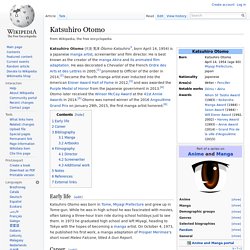
While he was in high school he was fascinated with movies, often taking a three-hour train ride during school holidays just to see them. In 1973 he graduated high school and left Miyagi, heading to Tokyo with the hopes of becoming a manga artist. On October 4, 1973, he published his first work, a manga adaptation of Prosper Merimee's short novel Mateo Falcone, titled A Gun Report. §Career[edit] Reports have suggested that Otomo will be the executive producer of the live action adaptation of his manga series Akira.[9] In a 2012 interview, Otomo said he will start a new manga series, set during Japan's Meiji period (late 1800's early 1900's).[10] It will be his first long-form work since Akira. §Bibliography[edit] §Manga[edit] §Artbooks[edit]
Anime. The earliest commercial Japanese animation dates to 1917, and production of anime works in Japan has since continued to increase steadily.

The characteristic anime art style emerged in the 1960s with the works of Osamu Tezuka and spread internationally in the late twentieth century, developing a large domestic and international audience. Anime is distributed theatrically, by television broadcasts, directly to home media, and over the internet and is classified into numerous genres targeting diverse broad and niche audiences. Anime is a diverse art form with distinctive production methods and techniques that have been adapted over time in response to emergent technologies. The production of anime focuses less on the animation of movement and more on the realism of settings as well as the use of camera effects, including panning, zooming and angle shots. §Definition and usage The etymology of the word anime is disputed. §Format §History §Genres. Memories (1995 film) Memories (also Otomo Katsuhiro's Memories) is an anime anthology film produced in 1995 by artist/director Katsuhiro Otomo which were based on three of his manga short stories.
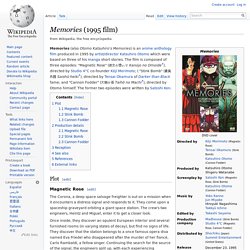
The film is composed of three episodes: "Magnetic Rose" (彼女の想いで, Kanojo no Omoide?) , directed by Studio 4°C co-founder Kōji Morimoto; ( "Stink Bomb" (最臭兵器, Saishū-heiki?) , directed by Tensai Okamura of Darker than Black fame; and "Cannon Fodder" (大砲の街, Taihō no Machi?) , directed by Otomo himself. The former two episodes were written by Satoshi Kon. The Corona, a deep space salvage freighter is out on a mission when it encounters a distress signal and responds to it.
Once inside, they discover an opulent European interior and several furnished rooms (in varying states of decay), but find no signs of life. Heintz finds a theater stage and sees Eva, who stabs him when he approaches. The Corona has been struggling against a powerful magnetic field coming from the station, pulling the ship towards it. Redline (2009 film) After a total of seven years in production, Redline was intended to premiere at the 2009 Annecy International Animated Film Festival and follow Summer Wars, Mai Mai Miracle, and Yona Yona Penguin as the fourth and final feature film Madhouse planned to release between summer 2009 and spring 2010.
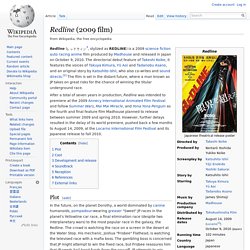
However, further delays resulted in the delay of its world premiere, pushed back a few months to August 14, 2009, at the Locarno International Film Festival and its Japanese release to fall 2010. While recuperating in a Dorothy hospital, Frisbee tells JP he's off the hook with his bondsman. Inside DEST Tower on Roboworld, the President asks his Secretary of Defense, Titan, for a report about ships landing on Roboworld's moon, EUЯPSS (pronounced Europass), a de-militarized zone that Roboworld signed away to refugees in the M-3 Nebula Federation.
The President obtains an oath from Colonel Volton to fight to the death to protect Roboworld and the M-3 Nebula. Metropolis (manga) The story begins with a scientist, Dr.
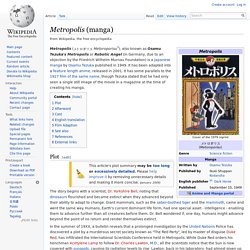
Yorkshire Bell, noting that dinosaurs flourished and became extinct when they advanced beyond their ability to adapt to change. Giant mammals, such as the saber-toothed tiger and the mammoth, came and went the same way. Humans, Earth's current dominant life form, had one special asset - intelligence - enabling them to advance further than all creatures before them. Dr. Metropolis (2001 film) In the futuristic city of Metropolis humans and robots coexist.
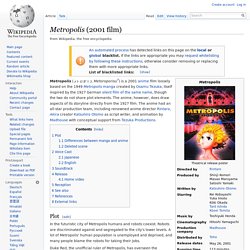
Robots are discriminated against and segregated to the city's lower levels. A lot of Metropolis' human population is unemployed and deprived, and many people blame the robots for taking their jobs. Duke Red, the unofficial ruler of Metropolis, has overseen the construction of a massive skyscraper called the Ziggurat, which he claims will allow mankind to extend its power across the planet. A wayward robot disrupts the Ziggurat's opening ceremony, only to be shot down by Rock, Duke Red's adopted son and the head of the Marduk Party, a vigilante group who's aim is to calm anti-robot sentiments. Private detective Shunsaku Ban and his nephew Kenichi travel to Metropolis to arrest Dr.
Shunsaku comes across the burning lab and discovers the dying Laughton, who gives him his notebook. Yoshikazu Yasuhiko. Yoshikazu Yasuhiko (安彦良和, Yasuhiko Yoshikazu?
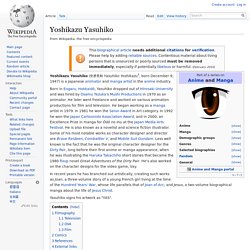
, born December 9, 1947) is a Japanese animator and manga artist in the anime industry. Born in Engaru, Hokkaidō, Yasuhiko dropped out of Hirosaki University and was hired by Osamu Tezuka's Mushi Productions in 1970 as an animator. He later went freelance and worked on various animation productions for film and television. He began working as a manga artist in 1979. In 1981 he won the Seiun Award in Art category.